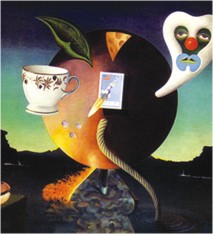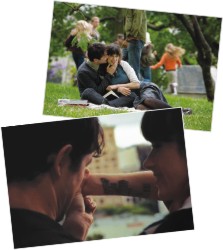 Title needed
Title needed
By S. S. Emil
It's been estimated that by 2011 the video game industry will be worth around 44 billion dollars. Yes. That's huge, we know.
Like everything else, movies or music, the way that video games are played, and made, have changed enormously. The first ever video game was (and is still probably the one with the most awesome title) Cathode Ray Tube Amusement Device, and since the exact details of this intricate game, or rather device, are too confusingly confuzzling, invented way back in 1947, I shall take the liberty of directly pasting from Reverend Wiki:
The game was a missile simulator inspired by radar displays from World War II. It used analogue circuitry, not digital, to control the CRT beam and position a dot on the screen. Screen overlays were used for targets since graphics could not be drawn at the time.
There were a few tids and bits in between until 1972 when came PONG. I'm sure this one requires no revelatory mention. Fast forward to about 20 years in the future, and you've got a whole industry built on the backs of geeks and nerds and entertainment seekers everywhere. You have King's Quest, you have Zork, you have Kung-Fu Master, and 1987 brings up Street Fighter, with Dragon's Lair in '83, the first game to have FMVs (Full motion video), you have Donkey Kong, you have Mario, you have Zelda, you have Metal Gear, and you have so many other things.
The point is that we live in exponential times. And everything around us grows and evolves exponentially. What was seemingly only possible in science fiction is now reality. The cost of producing and manufacturing more and more powerful hardware has gone down dramatically and continues to decrease even more as we move further and further away from the olden age of computer hardware.
One of the more rapidly changing factors in gaming are the graphical aspects. A fair few years ago, it simply became a race among developers to see who could dish out the most number of polygon counts in their game and maybe offer a bare minimum amount of story and gameplay with no mention of innovation whatsoever. Crysis with its ungodly visuals came into the industry like a roiling wave of nightmare and made computers everywhere bow down to its untameable graphics.
 And that got boring quite quickly.
And that got boring quite quickly.
Now it's all about the innovations. For some time now, independent developers have arisen in popularity thanks to primarily to their innovative ideas and different approaches to games, which more than made up for the fact that they didn't have as high a polycount as Assassin's Creed (which was dud, anyway and wouldn't take much to top it either). Braid, Plants vs Zombies, Scribblenauts and even the webflash game called Death vs Monstars. Portal combined the awesome visual power of Half-Life 2 and the awesome Aperture Science Handheld Portal Device to make for a very short and very entertaining game. It even had something of a story. The cake is of course a lie.
Stories often take backseats in favour of a good gameplay and this works occasionally so long as it's games like those mentioned above. Games with even the best of visual awesomeness fall short if the story or the gameplay isn't a hook. Once again, I'm looking at you Crysis.
Whether video games have evolved into something better or worse can't really be answered for sure. One thing is for certain however, our choices have expanded tremendously, and if there's something that we don't like, we now have the liberty to move to the next one. There's literally something for everyone. Whether you're a fan of humour (Monkey Island), casual (Peggle), sports (FIFA, maybe), action (God of War), or just really dark and morbid fantasy (The Path). There's something for everyone, and that can't be a bad thing.
New technologies are looming around the horizon. Case in point would be Xbox 360's Project Natal, where YOU are the controller. We can only wait and see what else makes the corner in the future of video gaming. Out of every 30 or so games released every month, 25 of them are likely to be utter nonsense, 3 of them mediocre and if luck has it 2 memorable or at least enjoyable games. But, that's more than what people got prior to the massive infestation of computers and consoles. Which, if you ask me, is pretty damned awesome.
Fun fact: In 1984, there were around 1,000 Internet devices, and in the 2008, there's around 1,000,000,000 devices.
Fun fact 2: It took the movie industry about 100 years to develop to maturity, but it only took video games 35 years, from the first baby steps of Pong (1972) to the virtual realism of Halo 3 (2007) (and of course, they're still growing).
Fun fact 3: Surgeons who grew up playing video games make 37 percent fewer mistakes.
PS: As a sane functioning member of the human race, I'm not willing to bet my life on the last statistic.

By Ahsan Sajid
 Folk icon Nick Drake's third, and last, full-length album was recorded over two nights at midnight in the October of 1971, during two two-hour sessions. It was only him and his acoustic guitar, splashed with re-dubbed piano only on the title track. With only under thirty minutes long, one could say the album ends prematurely, as does the life of its maker Nick Drake. Nick Drake's battle with depression finally overtook him at the age of twenty-six when he died of an anti-depressant overdose. Pink Moon is a testament to the throes of depression in the midst of which he had been alone all his life, with his softly keened singing and gentle strumming.
Folk icon Nick Drake's third, and last, full-length album was recorded over two nights at midnight in the October of 1971, during two two-hour sessions. It was only him and his acoustic guitar, splashed with re-dubbed piano only on the title track. With only under thirty minutes long, one could say the album ends prematurely, as does the life of its maker Nick Drake. Nick Drake's battle with depression finally overtook him at the age of twenty-six when he died of an anti-depressant overdose. Pink Moon is a testament to the throes of depression in the midst of which he had been alone all his life, with his softly keened singing and gentle strumming.
After two albums of tastefully orchestrated folk music, some of the least pretentious and most affecting, Drake chose a radical change for what was to be his final album. Not even half-an-hour long, with 11 short songs, Drake said after completion, very famously, that he had no more records. And Pink Moon more than anything else is the record that made Drake the cult figure he remains.
Pink Moon is a bleak testament to melancholy and alienation that has a haunting and pristine beauty. There are only eleven songs, most of which are under three minutes in length, which is why the album is not even a half-hour long, but there is a sense in which anything longer would be too much to bear. "Pink Moon," by itself, justifies Drake's status as a cult figure among those who love folk-rock.
 By the time of recording, Drake had retreated so deeply into his own internal world that it is difficult for anyone other than him to say what the songs are really about. His lyrics are extremely compressed, almost to the point where they read like haikus, much folklore inspired, almost childishly simplistic in their structure and very basic and subtle in their imagery. His voice conveys, in its keenness, moans and breathy whispers, an alluring sensuality, but he sings as if he were viewing his life from a great, unbridgeable distance. That element of detachment is chilling. To reinforce it, messages of isolation gradually float to the surface of the songs' spare, eloquent melodies. It's almost as if Drake knew what was going to happen, which often does bring up the question of suicide in his death.
By the time of recording, Drake had retreated so deeply into his own internal world that it is difficult for anyone other than him to say what the songs are really about. His lyrics are extremely compressed, almost to the point where they read like haikus, much folklore inspired, almost childishly simplistic in their structure and very basic and subtle in their imagery. His voice conveys, in its keenness, moans and breathy whispers, an alluring sensuality, but he sings as if he were viewing his life from a great, unbridgeable distance. That element of detachment is chilling. To reinforce it, messages of isolation gradually float to the surface of the songs' spare, eloquent melodies. It's almost as if Drake knew what was going to happen, which often does bring up the question of suicide in his death.
Lack of recognition in his lifetime deepened Drake's constitutional despair and may have contributed to his death from a possibly intentional anti-depressant overdose. If anyone needs confirmation as to why artists like Mark Eitzel, Elliot Smith, Lou Barlow, or Robert Smith hold Drake close to their hearts, it's all here, still as beautiful as the day it was released.
 500
500
Days Of Summer
By The Anarchist Kitten
(500) Days Of Summer is not a love story, or so will say the mock narrator in the very beginning of the film. Then what is it? A sensational, ground-breaking, original romantic comedy? No, it's not. It's arguably an exercise on the failings of the genre. Is it a view of love according to Morrissey, of The Smiths (more on this later)? No, not really. The central pairing between the two leads never attains anything like the melancholic dysfunction of The Smiths's loopy love songs.
What is (500) Days Of Summer if it isn't a love story? It looks like a love story; it sounds, tastes, feels like one, but we're going to be denied the truth by the pompous sounding narrator! The disappointing things about (500) Days of Summer begin with the title. The Summer in the title refers to a girl (Deschanel) and the 500 days to the length of time it takes for one love-sick young man named Tom (Gordon-Levitt) to get over her.
 Had the story been told in linear chronological order it might have been named 'Get The Hell Over Her, She Doesn't Care About You', because the male lead just refuses to get the message. However, a time-shifting structure jumps through different stages of the affair and saves the film's butt, making it entertainment with quirk. It's a gimmick, this quirkiness (Juno anyone? How about Nick And Norah's Infinite Playlist? Maybe Little Miss Sunshine? Had enough quirk shoved through your eye socket yet?) The charm of the movie is somewhat provided by the two leads. But both the actors play a role in this movie they could have played in their sleep. It's no challenge; going through their resume, anyone can figure out that these two characters in the movie are just who the actors themselves are.
Had the story been told in linear chronological order it might have been named 'Get The Hell Over Her, She Doesn't Care About You', because the male lead just refuses to get the message. However, a time-shifting structure jumps through different stages of the affair and saves the film's butt, making it entertainment with quirk. It's a gimmick, this quirkiness (Juno anyone? How about Nick And Norah's Infinite Playlist? Maybe Little Miss Sunshine? Had enough quirk shoved through your eye socket yet?) The charm of the movie is somewhat provided by the two leads. But both the actors play a role in this movie they could have played in their sleep. It's no challenge; going through their resume, anyone can figure out that these two characters in the movie are just who the actors themselves are.
(500) Days Of Summer has been hailed as the most original romantic comedy of recent times. Unless recent times count for the past month or so, this writer is not so certain. The most successfully enjoyable scenes are borrowed from other romantic comedies. For example, in the scene following Tom and Summer's first encounter of intimacy, there's a song and dance number in which we see him leaping and pirouetting through the streets of LA, with backup dancers joining in; that's straight out of The 40-Year-Old Virgin, taking only Hollywood movies into consideration. There's also an obligatory karaoke scene that every romantic comedy has had since it was introduced in My Best Friend's Wedding.
The filmmakers try to desperately demonstrate just how original they are by telling the story in a time-shifting structure, moving back and forth between different points in the relationship. Fractured narratives can sometimes enhance the dramatic impact of a story, as in movies such as Pulp Fiction or Memento, where this tried and tested technique has really worked; but all too often the technique is just a way of trying to give shallow, one-dimensional material the appearance of profundity and that is very much what has happened here. If you are particularly bored, you may find amusement in lining up the story chronologically and finding out just how common it really is. This is wannabe indie, at best. Oh, and the obligatory Belle and Sebastian reference common in all indie movies, I see what you did there, (500) Days Of Summer makers.
With all that said, when you have time to waste, this reviewer whole-heartedly suggests you waste it watching (500) Days Of Summer. So what if it's a Hollywood-hatched formula to pull our purse strings? We're not losing much if any amount of entertainment comes off it.

